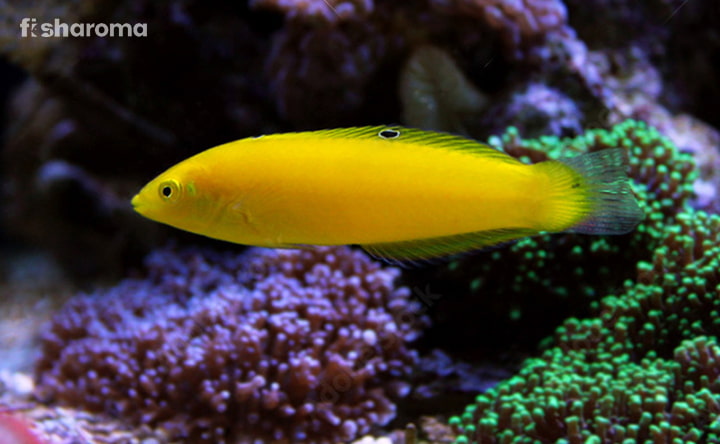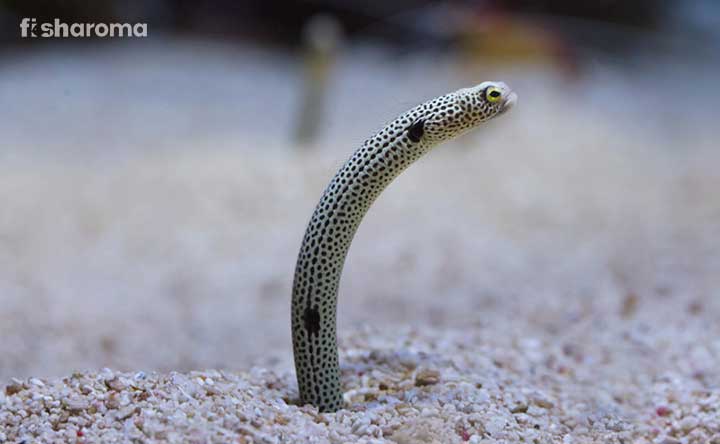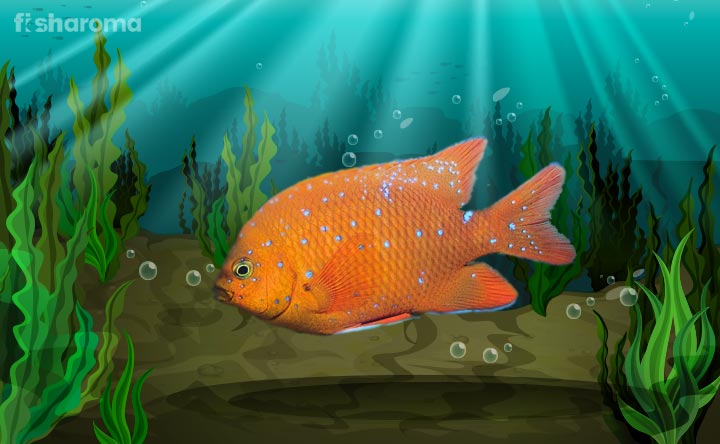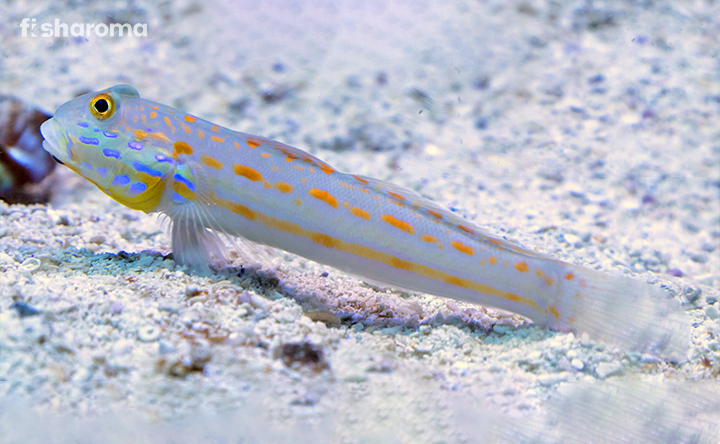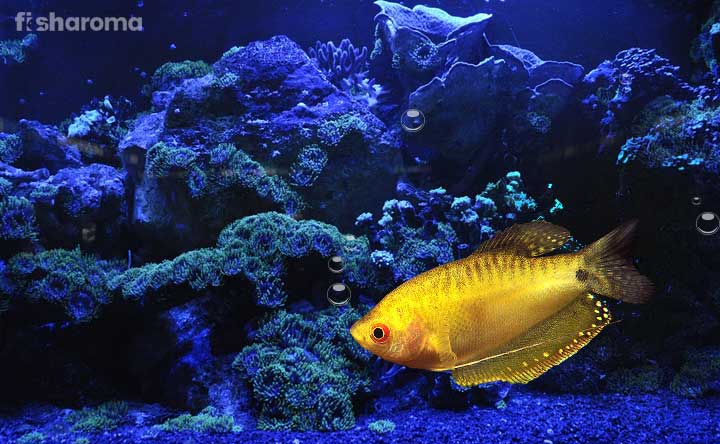Coral Beauty Angelfish: A Thorough Care Guide To This Flamboyant Saltwater Fish
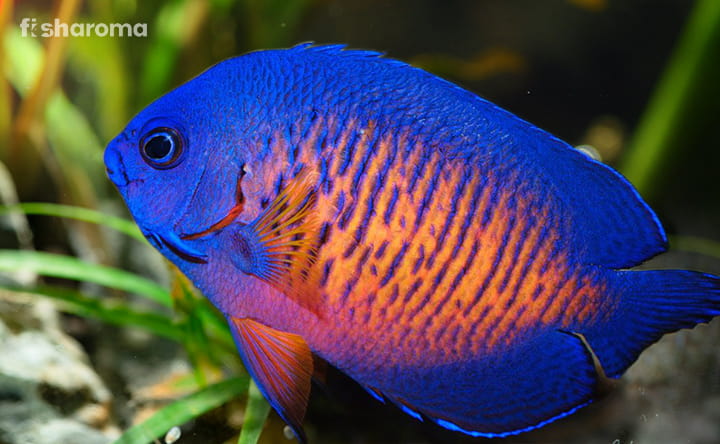
- Origin & Habitat of Coral Beauty Angelfish
- Appearance of Coral Beauty Angelfish
- Behaviour of Coral Beauty Angelfish
- Lifespan of Coral Beauty Angelfish
- Diet of Coral Beauty Angelfish
- Tank Requirements for Coral Beauty Angelfish
- Water Type for Coral Beauty Angelfish
- Compatibility of Coral Beauty Angelfish
- Breeding of Coral Beauty Angelfish
- Summary
Coral Beauty Angelfish is a type of marine Dwarf Angelfish. They belong to the Actinopterygii class and Perciformes order. These fishes are tremendously popular among saltwater aquarists.
Not only are these fishes vibrantly coloured, but they are also comparatively easy to take care of and are quite hardy in nature. Additionally, Coral Beauty Angelfishes are readily available at your local pet store and they are also quite inexpensive compared to other saltwater Angelfishes.
If you are interested in having a Coral Beauty Angelfish as your aquarium mate, then you are at the right destination. In this article, we will provide you with expert guidance and information on their care guide, diet, behaviour, breeding and more.
So, follow through to know it all!
Key Specifications of Coral Beauty Angelfish
Coral Beauty Angelfish is a treasure that you’ll love having in your aquarium. So, if you are thinking about getting one for your reef aquarium then, below is a brief outline of their primary characteristic traits. Let’s have a look at them!
| Scientific Name | Centropyge bispinosa |
| Origin | Indian and Pacific Ocean |
| Lifespan | 10-15 years |
| Colour | Reddish-orange body with bluish-purple stripes |
| Temperament | Semi-aggressive |
| Size | 3-4 inches |
| Diet | Omnivore |
| Family | Pomacanthidae |
| Compatibility | Other similar-sized species of fishes |
| Tank Size | 70 Gallons |
| Care Level | Easy |
| Water Temperature | 22-27 Degrees Celsius |
| Water Conditions | pH 8.1-8.4 |
| Breeding | Egg-layer |
Overview
Coral Beauty Angelfish (Centropyge bispinosa) is one of the most sought after and gorgeously coloured Dwarf Angelfishes out there. They are also commonly known as Two-spined Angelfish and Dusky Angelfish. These fishes have a brilliant colouration and have a great personality as well. These fishes dwell in the middle and bottom layers of the tank. Also, they are quite easy to care for.
Coral Beauty Angelfishes are generally semi-aggressive in nature. They love to swim through swift water currents. These fishes are quite hardy. Howbeit, that doesn’t eradicate the fact that they need proper care and maintenance to lead a happy and healthy life in an aquarium environment. These fishes are very sensitive to undesirable changes in the water quality and so, you need to make sure that you are paying keen attention to their tank conditions and well-being.
Origin and Habitat of Coral Beauty Angelfish
Coral Beauty Angelfishes are native to the Indo-Pacific region, stretching a vast range of areas from East Africa and Australia to South-East Asia. These fishes are mostly found on rocky reefs or in regions rich with corals. These include the Great Barrier Reef in Australia, Tahiti, East Africa and Tuamoto Island.
Coral Beauty Angelfishes mainly thrive in shallow water regions as they are mostly mid and bottom dwellers. These fishes inhabit areas with a normal to slightly high water temperature, an alkaline pH, high salinity and an adequate water flow.
Appearance of Coral Beauty Angelfish
Coral Beauty Angelfishes are extremely voguish with unique and eye-catching patterns on their body. We’ll have a look at this in the “colour” section below.
Coral Beauty Angelfishes have a short and flattened body shape. Their bodies resemble a half-disk shaped pattern and they have an obtuse snout.
These fishes are types of ray-finned fishes. They have well-defined and saw-edged dorsal, caudal and anal fins. The dorsal fin is made up of 14 spines and 17-18 soft rays. The anal fins, on the other hand, consist of 3 spines and 17-19 soft rays.
Dimorphism
There is no proven and definite way of distinguishing between a male and a female Coral Beauty Angelfish. In fact, did you know that these fishes are born female? The ones which get bigger in size and are dominant, morph into males.
Size
An adult Coral Beauty Angelfish can grow up to 2.5-3 inches in length. If given a nutritious diet and maintained at optimum conditions, these fishes can even grow up to 4 inches in size.
Colour
Coral Beauty Angelfishes are popularly known for their singularly vivid and diversified colouration. The baby Coral Beauty Angelfishes have reddish colouration on their bodies with purplish-blue stripings. Adult fishes have a reddish-orange and yellow hue to their skins. Their heads, dorsal, caudal and anal fins have a solid royal blue colour. Whereas, the pectoral and ventral fins have an orangish shade to them.
Behaviour of Coral Beauty Angelfish
Coral Beauty Angelfishes are generally semi-aggressive in nature. They have territorial instincts and so, you’ll notice that two male Coral Beauty Angelfishes will get tremendously aggressive towards one another and will fight till death. To avoid this, a big tank is an ineradicable necessity.
Additionally, their behaviour also depends on the algal growth inside the tank. Since these fishes are core algae-grazers, they won’t mind any other fish if there is enough algae inside the tank. However, if the algal count inside the tank does not satisfy their needs, then, these fishes won’t stop themselves from attacking other fishes including the smaller ones, the peaceful ones and even those of their own kind.
In spite of the fact that they have a quick temper, Coral Beauty Angelfishes are very shy and so they prefer to hide in caves and amidst the rocks. So, make sure that you add plenty of hide-out places inside your saltwater aquarium.
Lifespan of Coral Beauty Angelfish
Coral Beauty Angelfishes can live up to 10-15 years in the wild. But in captivity, such a long lifespan is rarely experienced. Then again, if you chose a fish which has been bred in captivity, then you can expect them to accompany you for 15 long years as they can adapt to the tank environment and conditions easily. Make sure that you provide them with the best diet, water and tank conditions so that these fishes can live a long and happy life.
Diet of Coral Beauty Angelfish
Coral Beauty Angelfishes are known for their liking of diverse foods. They love to feed on algae growing on rocks. They will also munch on the aquatic live vegetation, corals, detritus and even fleshy foods. In captivity, you don’t have to worry much about their diet as they feed on anything that they find delicious enough.
They follow an omnivorous diet and the foods that you would want to feed them are readily available. Although they love eating algae, you can’t restrict their diet to that only. This will deprive your Coral Beauty Angelfish of all the other essential nutrients that can be found in meaty, leafy and commercially available fish foods.
They Feed on:
- Algae
- Detritus
- Small Polyps
- Coral Polyps
- Tiny crustaceans including copepods
- Aquatic vegetation
Vegetarian Diet include:
- Macro Algae
- Diatoms
- Turf Algae
- Sea Lettuce
- Crustose Coralline Algae
Meaty Diet include:
- Mysis Shrimp
- Frozen Brine Shrimp
- Clams
- Mussels
- Squids
- Shaved Shrimps
- Krill
Commercially Available Foods:
- Algae Tablets
- Spirulina Tablets
- Dried Marine Algae
- Supplemented Vitamins
- Frozen fish food
- Fish Pellets and Flakes.
You must feed your Coral Beauty Angelfish at least twice a day. If the algal growth inside the tank is healthy, then you know that your fish has a great deal of food to munch on. So, in that case, you can feed them once a day. Also, make sure that you don’t overfeed them as it may cause serious gastrointestinal problems.
You can feed your Coral Beauty colour enhancing saltwater flakes. This type of food will ensure that the vibrancy of the fish’s coat is maintained and that it doesn’t fade away. However, make sure that you don’t overfeed them as they may cause serious illnesses if continued for a long time.
Tank Requirements of Coral Beauty Angelfish
Do Coral Beauty Angelfishes immensely intrigue you? Do you want to have them as your pet? If so, then you will need to put real effort into their maintenance, tank conditions and care. Here’s an expert guide on the various tank requirements of a Coral Beauty Angelfish. Get detailed information and suggestions on setting up a saltwater fish tank.
Tank Size
For a Coral Beauty Angelfish, you should get a minimum tank size of 70 Gallons. No doubt these fishes are quite smaller in size, growing to a maximum length of only 4 inches.
No matter the size, these fishes do require a large area to swim and forage around for food. A small, overcrowded tank will pose a threat by making your Coral Beauty Angelfish more aggressive and stressed out.
Tank Shape
Since Coral Beauty Angelfishes are mid-bottom dwellers, you should really consider getting a rectangular shaped tank for them. They require adequate space to swim. So, a sphere-shaped fishbowl should definitely not be the right choice.
Tank Lid
There are chances that your Coral Beauty Angelfish may jump out of the tank. This might ultimately suffocate them and cause death. So, make sure that you get a lid for your tank.
Additionally, a tank lid will also protect your tank from all the unnecessary foreign dust particles and harmful substances. Also, if you have pets like a dog or a cat at your home, then you should really consider getting a tank lid to prevent any sort of accident.
Make sure that your tank lid is tightly closed.
Substrate
Coral Beauty Angelfishes are mid-level dwellers. They love to roam around near the middle of the tank. So, when it comes to substrate particles, you can use anything which is suitable for a reef tank. You can add rock rubbles at the bottom of your tank. This will not only help your fish relax, but it will also ameliorate the nitrogen cycle.
Filter
Coral Beauty Angelfishes require a clean and accurately maintained tank setup. A strong filtration technique and a proper air filter will ensure that the tank is safe from unwanted particles, foreign toxic substances and unwanted chemicals like nitrates.
Ornaments
For a Coral Beauty Angelfish tank, you should add lots of live rocks, caves and hiding places. These rocks allow the fishes to hide, feel safe and relax. Adding live rocks and rocky cracks to your tank, will mimic their natural habitat and help your Coral Beauty Angelfish deal with stress. Additionally, the rocks will also allow the algae to grow on them. Coral Beauty Angelfish love to nibble on algae growing on the rock surfaces.
Lighting
Since Coral Beauty Angelfishes are mid-level dwellers, they will require moderate to dim lighting. A light source is necessary in that case because live rocks do require light energy to allow the growth of algae on them. To encourage spawning, it’s recommended that you go for blue and dim lighting arrangements inside your reef tank.
Presence of Flora
You might add plants to your saltwater aquarium as well. The addition of Coral Beauty Angelfish safe vegetation to your tank will make your fish feel at home as it will mimic their natural environment. Also, natural vegetation will increase oxygenation and will help with the ventilation inside the tank.
You can add artificial plants to your tank if you find your fish destroying the natural vegetation. Make sure that the artificial plants are made of toxin-free materials.
Cleaning Methods
Ensure that you regularly clean your reef tank. Use a sponge or a plastic blader to clean and scrape out the algal growth on the inside of the tank glass/acrylic walls. Excess growth of algae will reduce oxygenation and will affect the fish’s health.
You could add activated carbon to your saltwater tank. These activated carbons rid the tank of toxic organic and inorganic chemical buildup. Use aquarium vacuum cleaners to remove deposited food and waste particles within the substrate layers.
Also, make sure that you are changing around 10% of the tank water at least once or twice a week. Watch if you are taking the right measures for cleaning your fish tank.
Water Types for Coral Beauty Angelfish
When it comes to Coral Beauty Angelfish, it’s a must that you take the right measures to maintain the proper tank water conditions. These fishes are very sensitive to even a slight and undesirable change in the water parameters. Ensure that you fully cycle your reef tank before you introduce your Coral Beauty Angelfish to the aquarium.
So, come let’s have a look at their essential water requirements.
Water Temperature
Coral Beauty Angelfishes thrive the best in water temperatures ranging from 22-27 Degrees Celsius. Use the best heater and aquarium thermometer to maintain, regulate and check your aquarium temperature.
pH Level
Coral Beauty Angelfish live the best in a slightly alkaline environment. You should keep the pH of the water between 8.1 and 8.4. So, you must maintain the proper pH level inside the tank.
Hardness
For a Coral Beauty Angelfish, you need to ensure that the water hardness lies anywhere between 8-12 dKH.
Specific Water Gravity
Since Coral Beauty Angelfishes are mid-bottom level dwellers, you should maintain the tank gravity between 1.020 to 1.025.
Water Flow Rate
Coral Beauty Angelfishes love to swim through strong water currents. So to make them happy and feel at home, you should install pumps in your aquarium which will maintain the required and proper water flow rate.
Compatibility of Coral Beauty Angelfish
Coral Beauty Angelfish is semi-aggressive in nature. They can be peaceful, and they can be aggressive. It all depends on their health, diet and obviously the tank mates. So, when it comes to choosing the right tank mates for your Coral Beauty Angelfish, do make sure that you are paying the right attention and are aware of their compatibility factors.
If you want to keep more than one Coral Beauty Angelfish in your tank, then you should add them at the same time and make sure that they grow up together. If you plan on adding one Coral Beauty Angelfish later on, then there are high chances that the existing Coral Beauties inside your tank will turn tremendously aggressive towards them.
Peaceful Fishes?
If you want to add reposeful fishes to your tank then, that’s absolutely fine provided that your tank size is 70 Gallons, which is big enough to let your Coral Angelfish swim freely. If the tank size is small, then your Coral Angelfish may develop the territorial instinct, which will lead it to bully, attack and even kill other quiet fishes inside the tank.
Slow Swimmers?
And when it comes to slow swimmers, you should be cautious because Coral Beauty Angelfishes are very active. Slow swimmers will take time foraging for food, and the Coral Beauties won’t spare them that opportunity. You might find that the slow swimming fishes in your tank have died of starvation alone.
Suitable Tank Mates
Unsuitable Tank Mates
Corals and Invertebrates will obviously confer your reef tank with a natural saltwater ambience. You can add them to your tank which is obviously quite sizeable. However, as we have seen before that, Coral Beauty Angelfishes feed on anything, be it plants or meats, there are high chances that they would nip at and won’t spare the lives of corals and invertebrates. These include shrimps, clams, sea urchins and other invertebrates.
Is Coral Beauty Angelfish reef-safe?
Coral Beauty Angelfishes are not reef-safe. If you put them in a reef tank, you’ll often find them picking and nipping at the soft coral polyps like the Acropora species and the Xenia polyps. They also won’t stop bothering the sessile invertebrates which include clams, tunicates and fanworms.
Then again, this isn’t entirely an obvious fact. There are chances that your Coral Beauty Angelfish will leave the corals on their own if they feel satisfied enough with the algal growth inside the tank. So, yes, there are always exceptions!
We understand that you might love the idea of a reef tank, decorating the insides with corals. For that purpose, we recommend you get Toadstool and Leather corals. These corals have an unpleasant and a sickening taste, which would most likely fail to tempt your Coral Beauties.
Breeding of Coral Beauty Angelfish
When it comes to breeding Coral Beauty Angelfish, then it is indeed a knackering job. First off, gender differentiation is quite hard because there are no specific physical attributes unique to a male and a female Coral Beauty Angelfish. In general, you’ll notice that a male fish is bigger than a female one.
Secondly, creating a mating pair is a difficult task and you have to rely on the trial and error method. If two males are paired then, you’ll observe that they are always fighting. If by chance, you have been successful at pairing a male with a female Coral Beauty Angelfish, then there are fewer chances of fights as they’ll gradually get to know each other and start forming a bond.
It’s always recommended that you choose fishes which have been bred in captivity. This will allow the fishes to attune to the aquarium environment in no time.
Breeding Parameters
Choose a separate 70 Gallons tank for the breeding purpose solely. Isolate the pair to the tank and let the fishes get comfortable around each other. A mating pair is unlikely to attack each other. You should feed them nutritious food at regular intervals. A dim to dark-hued lighting will encourage the mating. So, make sure that the breeding tank doesn’t receive a greater intensity of light.
How Does the Breeding Take Place?
The mating couple may take days, months, or even years to breed. Once the breeding is done, the female fish will lay the eggs. The eggs float freely and no nest formation takes place. After spawning, the male fishes fertilize and tend to the eggs.
How to take care of the fries?
Once fertilized, you should separate the eggs into a different tank. This will save the eggs from a potential attack by the adult Coral Beauty Angelfishes. Make sure that you keep the tank water clean by changing it at regular intervals. Allow good oxygenation and airflow. Install a proper DIY filtration system and ensure that the water condition and the parameters are at their optimum.
Coral Beauty Angelfish eggs hatch within a couple of days after fertilization. Once the fries start to freely swim, you can feed them live infusoria, brine shrimps and microworms. You should feed the fries at least four or five times a day.
Disease and Treatment of Coral Beauty Angelfish
Coral Beauty Angelfishes are quite hardy. However, there are certain common saltwater diseases that you must look out for.
Saltwater Ich
Marine Ich is a common saltwater fish disease caused by certain parasites. The most noticeable symptoms are white spots all over the fish’s body and tail, lethargy and loss of appetite.
To treat saltwater ich, you should first separate the infected fish to a new tank. Then, make sure that you are regularly changing the water in the existing tank and are using strong filtration techniques to remove the presence of any sort of parasitic life forms. Additionally, you should consult a vet if the problem persists. Hyposalanity is one great way of treating a fish with saltwater ich.
Dropsy
Dropsy is a common saltwater disease which is caused by certain bacteria. This disease is primarily a result of the accumulation f fluid inside the fish’s body. This, in turn, causes bloating.
To treat this disease, ensure that you properly clean the tank and the water. Also, make sure that you feed your fish the best quality food. If the problem persists, then visit a vet. You can treat the infected fish with penicillin-based rugs.
Summary
On a closing note, if you are looking forward to including a Coral Beauty in your family then, let us tell you that you’ve got an amazing taste. These Dwarf angelfishes are utterly gorgeous with an equally admirable personality.
Additionally, if you are new to the world of fishes and aquariums then, a Coral Beauty would be a good choice for you as this fish is easier to care for compared to other Angelfishes. This is one reason why these fishes are a celebrated choice among many saltwater fish-keeping hobbyists.
So, if you are yearning to get saltwater which is not only ecstatically beautiful but also has a winsome persona, then go ahead! These Beauties will surely make great companies and will absolutely enthral you. Their presence will lighten up your tank! Do make sure that you are taking proper care of their needs and are looking after their well-being.
Similar Care Guides
If this article interests you then, don’t forget to visit our sites for further care guides on other saltwater fishes.
- Care Guide for Firefish Goby: These species of Dartfishes have a brilliant and fiery hue to their skins. They are extremely popular among reef aquarists.
- Care Guide for Bellus Angelfish: These Angelfishes are extraordinarily beautiful and “angel-like”. They are vibrantly patterned and you will be enamoured by their presence.
- Care Guide for Garibaldi Fish: These saltwater fishes are known for their massive size and long lifespan. So, if you want a companion for a real long time, then you might consider getting these fishes!

